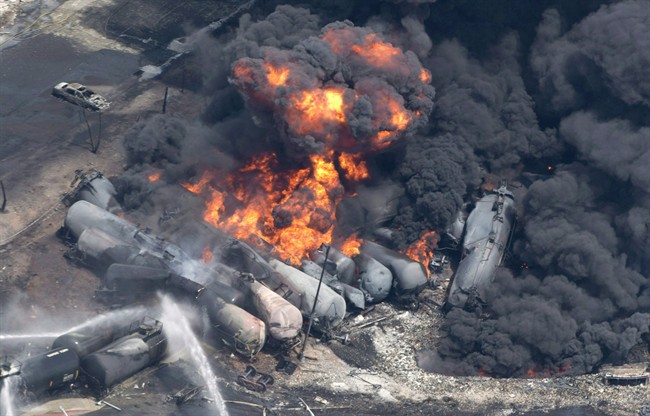Ten years after a runaway train derailed and killed 47 people in Lac-Mégantic, Que., residents are still waiting for a promised railway bypass, and they fear the increasing number of railcars carrying hazardous materials through their town will lead to another disaster.

Mayor Julie Morin says the trains transporting such things as propane, diesel and sulphuric acid have got longer, threatening to turn the city’s downtown area once again into a mess of charred ruins and twisted metal.
“We see it with our own eyes,” she said about the growing length of the trains travelling through the area, where on July 6, 2013, a train carrying 72 tank cars filled with crude oil derailed and exploded, killing 47 people and destroying entire city blocks.
If a derailment occurs, first responders have access through a mobile application to a detailed description of the materials inside the railcars and the associated risks. But Morin says city council wants advance notice about the materials coming in by train, in order to better plan for emergencies.
“We don’t have any information,” she said in a recent interview. “Municipalities don’t know in advance what goes through their town.”
Federal law, however, only requires railway companies to inform municipalities after the fact. Companies have until 30 days after the end of each quarter to provide a report on the dangerous goods that have travelled on railways. Transport Canada cites safety and logistical reasons to explain the rule.
- As Canada’s tax deadline nears, what happens if you don’t file your return?
- Posters promoting ‘Steal From Loblaws Day’ are circulating. How did we get here?
- Planning a summer trip to Quebec’s Îles-de-la-Madeleine? You’ll have to pay up
- Drumheller hoping to break record for ‘largest gathering of people dressed as dinosaurs’
Morin may not get advance data about the materials being transported through her downtown, but she has a pretty good idea of what is in the trains — thanks to Robert Bellefleur, a citizen who tracks the frequency and length of trains, as well as the materials they transport.
When The Canadian Press met Bellefleur recently, he was using a ladder to climb a tree and change the batteries in a camera that films passing trains on tracks near his house. The images allow him to identify what’s inside by entering the four-digit codes on the side of the cars into an online database.
“A month ago, I saw 40 tank cars carrying propane gas, one after another” in a train about 200 cars long, said Bellefleur, a spokesperson for a local citizens group that advocates for railway safety.
He said that 10 years ago, trains didn’t exceed 100 cars, but today, “they are monster trains.” Bellefleur said in recent months they have been the longest he’s ever seen in the town.

Canadian Pacific, which owns the tracks through Lac-Mégantic, would not confirm whether there has been an increase in the frequency and length of trains carrying dangerous goods. “The volumes and types of railway traffic to be shipped determine the frequency and length of trains,” the company said in an email.
Bellefleur says his worst fear is that a train suffers a mechanical failure while travelling on the downward slope from Nantes, Que., toward Lac-Mégantic. The 2013 disaster happened when the brakes failed on a train parked in Nantes and it barrelled down the slope into the town.
Morin says that due to the topography of Lac-Mégantic and the “collective trauma” of the derailment, a bypass needs to be completed “as quickly as possible.”
After the disaster, many residents no longer wanted trains to pass through downtown, so the bypass became a top priority for the municipal council at the time — and remains a priority today. But 10 years later, the bypass that was supposed to be part of the community’s healing process is still not built.
“The rail tragedy happened on July 6, 2013, and they (railway companies and Transport Canada) cleared the wreckage and resumed train operations,” Morin says. “But we, 10 years later, are still in the tragedy, managing social tensions and all the economic and social challenges it brought.”
In 2018, Prime Minister Justin Trudeau and then-Quebec premier Philippe Couillard announced joint funding for a project to divert trains around the heart of the community, a proposed 12.5-kilometre route that passes through the municipalities of Nantes, part of Lac-Mégantic and Frontenac.
The project has been mired in delays and met by vocal opposition from unions and neighbouring communities. Some locals have raised concerns about the environmental impact of the bypass, including on nearby wetlands and drinking water wells. Farmers, meanwhile, have accused Ottawa of not listening to their concerns and of acting in bad faith.
Despite the opposition, the federal government has no intention of backing down. Ottawa released a statement in mid-June confirming it would expropriate land for the bypass by Aug.1 from 43 owners with whom the government couldn’t reach a deal. In response, affected residents said they were mulling a legal challenge.
It is expected that once the land acquisition process is complete, the Canadian Transportation Agency will approve the final project, after which construction could begin.

Morin says that aside from the tension the bypass has created between Lac-Mégantic and neighbouring towns, she is optimistic about the future of her city.
“We are slowly but surely reclaiming the territory,” she said. “We are taking it back, and all I hope is that we continue on this path and that along the way, we do not forget to support each other mutually and collectively, because even though it has been 10 years, it is still an open wound.”
In order for that wound to heal, the trains have to be diverted, she said. “The only way to reduce the risk of a derailment is to move the trains away from the downtown area.”



Comments